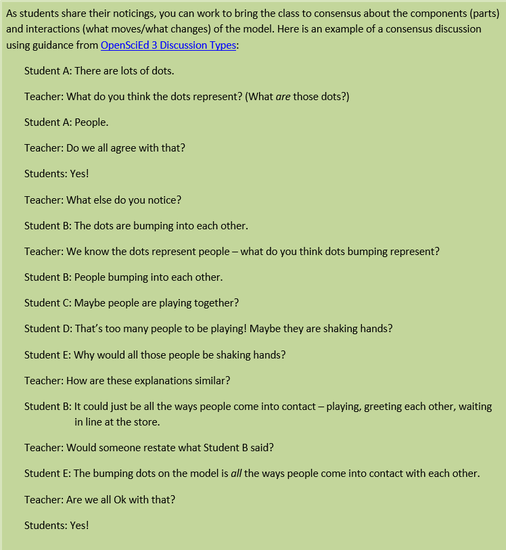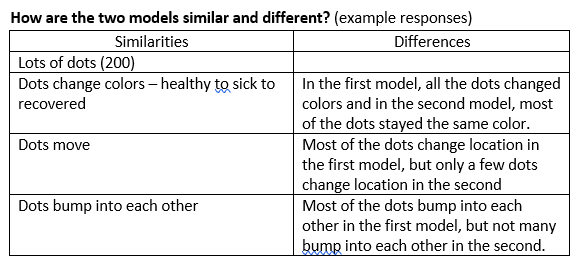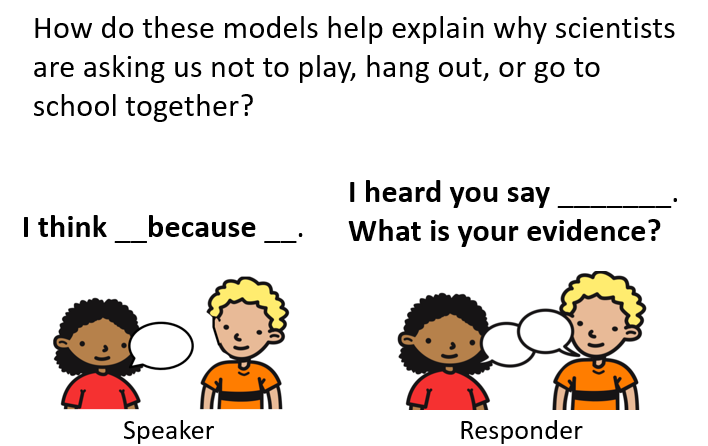Elementary | Daily Do
Why Do We All Have to Stay Home?
Elementary Version

Biology Crosscutting Concepts Is Lesson Plan Life Science Mathematics NGSS Phenomena Science and Engineering Practices Teacher Preparation Elementary Grade 1 Grade 4
Sensemaking Checklist




Introduction
The COVID-19 global pandemic has led to major changes in our everyday lives. The biggest changes for young children are likely staying home from school and no longer being able to spend time with extended family and friends.
In this task, Why Do We All Have to Stay Home?, students and their families engage in science and engineering practices and use the thinking tools of patterns and cause and effect to figure out how social distancing (and shelter in place) slows the spread of the coronavirus. This task is designed to help young children talk about changes they've seen and heard about, understand how the coronavirus is spread, and take action to keep themselves and their families healthy and safe.
Discussions play a large role in supporting students' sensemaking in this task. You may want to first introduce or remind students of classroom norms before you begin. OpenSciEd has a set of classroom norms that support students in sharing, listening, and respectfully critiquing and building on others' ideas.
A printable version of the Why do we all have to stay home? Elementary Version lesson plan in now available!
Tell your students, "We're going to watch what happens when an imaginary germ spreads in a town where people are playing, hanging out, and going to school together."
Ask, “What do you notice or wonder about this model?” Start with the simulation off, and then let it play all the way through.
As students share their noticing, ask them a clarifying or probing question as appropriate to get them to think more deeply about the components (parts) and relationships (what moves?/what changes?) represented in the model. You may want to go back to the simulation and ask each student to follow the journey of one dot from beginning to end if they have difficulty answering the questions.
If you are facilitating this task with two or more students (or family members), you have a wonderful opportunity to bring the group to consensus on the components and interactions represented in the model. See the example consensus discussion below using the questions provided and guidance from OpenSciEd 3 Discussion Types.

Tell students, “Now we’re going to watch what happens when the imaginary germ spreads in a town where people are mostly staying at home. Scientists call keeping close to home social distancing.” (Note: Keeping close to home more closely represents shelter in place. If students ask the difference, social distancing is keeping a distance [6 feet recommended] from others and only gathering in groups of 50 or less.)
Ask student how this model is similar to the first model (start with the simulation off, then let it play through while students are making observations). Record the similarities. Play the simulation again, this time asking students to notice differences between the first and second models. Record the differences students observe. You may need to run the simulation 2-3 times.
See image below for examples of similarities and differences.

Ask students to turn and talk to a partner to answer the question, “How do these models help explain why scientists are asking us not to play, hang out, or go to school together?”
To facilitate the conversation, give students the following prompts:
Speaker: I think _____ because ____.
Responder: I heard you say _____. (to honor speaker's ideas) What is your evidence?
As you listen to the partner conversations, remind students to use the models and the similarities and differences list to support their thinking. Make sure each student takes a turn as speaker and responder.

If you have two or more students (or family members), have a building understanding discussion. Start by asking students to share their claims. As each student shares their claim, ask them to share evidence from the models that supports their claim.
Some questions you might pose to the class to encourage critique and student-to-student interaction include these:
- Does any group have evidence to support Group A’s claim?
- What data do we have that challenges Group B’s claim?
- ______ and ____ made similar claims. Did you have the same evidence?
- ______, what do you have to say to _____ about her idea? It sounds pretty different from yours.
To conclude the building understanding discussion, consider using the following prompt:
What can we conclude about how these models help explain why scientists are asking us not to play, hang out, or learn together?
NSTA Collection of Resources for Today's Daily Do
NSTA has created a Why do we all have to stay home? Elementary Version collection of resources to support teachers and families using this task. If you're an NSTA member, you can add this collection to your library.
Check Out Previous Daily Dos From NSTA
The NSTA Daily Do is an open educational resource (OER) and can be used by educators and families providing students distance and home science learning. Access the entire collection of NSTA Daily Dos.
Acknowledgement
The coronavirus simulations used in this task are part of the story "Why Outbreaks Like Coronavirus Spread Exponentially and How to "Flatten the Curve," published in The Washington Post on March 14, 2020.


